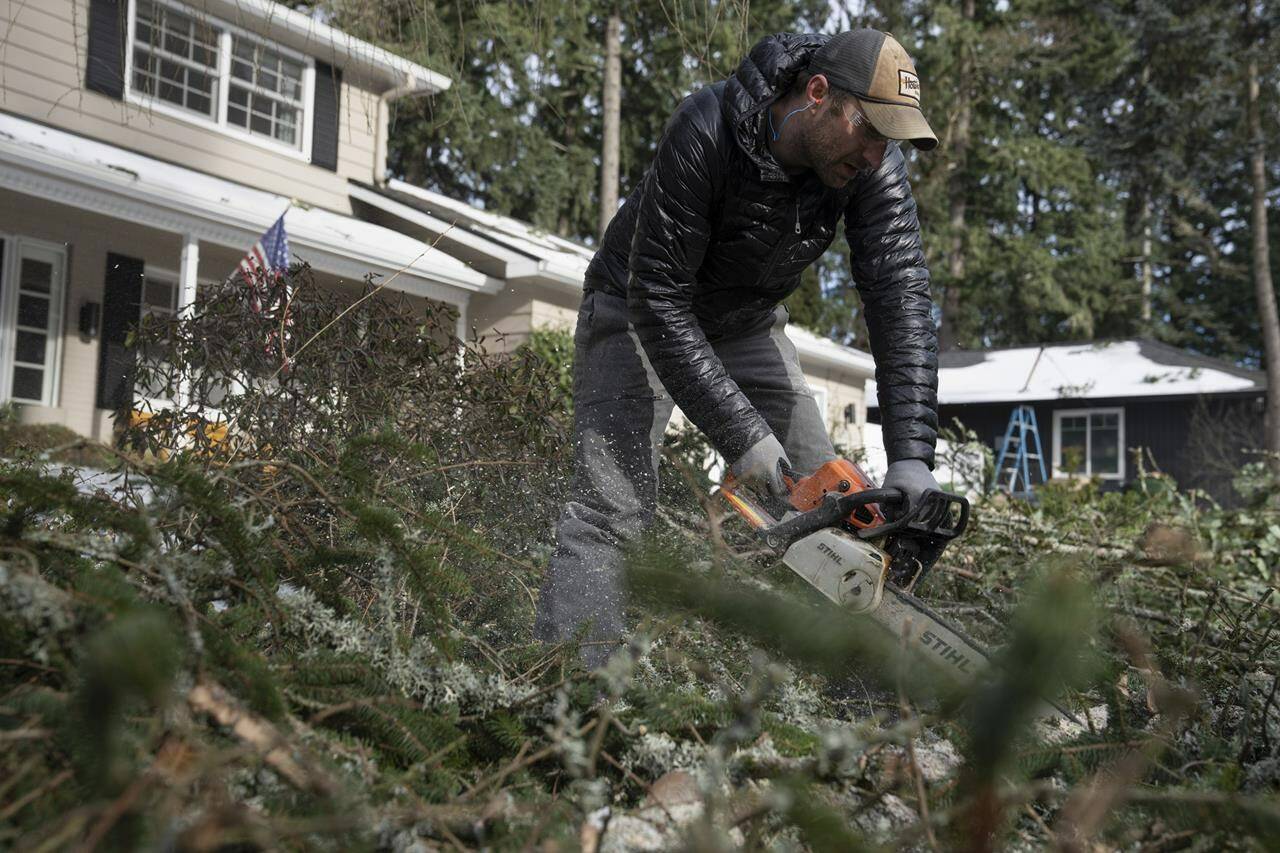An ice storm threatened to topple towering trees onto power lines and turned mountain highways treacherous Wednesday in the Pacific Northwest, where residents were urged to avoid travel.
Around Portland, Oregon, long icicles dangled from roofs and cars, and ice encased branches, plants and leaves like thick glass.
Swaths of the area were under warnings early Wednesday for as much as an inch of ice, promising only to add to the damage wrought by a powerful storm that hit over the weekend and was blamed for at least seven deaths.
The warning area was reduced to parts of southwest Washington and northwest Oregon, including Portland, a metro area of over 2 million.
Schools and government buildings closed as authorities warned of icy roads and the chance of new power outages, even as crews struggled to restore electricity to thousands blacked out for days.
The storm canceled or delayed flights, including in Vancouver, British Columbia, where heavy snow blanketed the city and snarled traffic, The Canadian Press reported. The city could get nearly 8 inches (20 centimeters) of snow by the evening.
The storm hit the northwest corner of the U.S. as much of the rest of the country coped with bitter weather that in some places put electricity supplies at risk. More than 100,000 homes and businesses — mostly in Oregon — lost power across the country, according to PowerOutage.us. Customers in Texas and California also lacked electricity.
Freezing temperatures spread as far south as North Florida on Wednesday morning, said Bob Oravec, a National Weather Service forecaster. It was 12 degrees (minus 11.1 Celsius) early Wednesday in Atlanta, where thousands of students returned to school after icy weather Tuesday.
It was 5 degrees in Chicago (minus 15 Celsius) and 6 degrees (minus 14.4 Celsius) in Detroit — significantly colder than Alaska’s capital of Juneau, where it was 18 degrees (minus 7.8 Celsius). Some Midwesterners managed to find a bright side.
“It’s probably the most beautiful time in Chicago, ever,” Richard Wineberg said as he admired the snow-covered landscape.
New York and Philadelphia ended a drought of sorts, with snow falling in both cities. Five people were struck and killed by a tractor-trailer on Interstate 81 in northeastern Pennsylvania after they left their vehicles following a separate crash on slick pavement. Investigators were still determining the exact cause.
In western New York, the weather was blamed for three deaths in three days. Two people were apparently stricken while clearing snow, and a third was struck by a vehicle while brushing snow from his car, Erie County officials said Wednesday.
Heavy lake-effect snow was forecast in Buffalo, with up to 4 inches (10 centimeters) an hour expected through the afternoon. City hall was closed, school districts declared snow days, and travel bans were issued for several suburbs. The blast came days after a storm that delayed an NFL playoff game for a day.
Early Wednesday, Patrick Sahr shoveled snow from his car and driveway in Buffalo after at least 18 inches (45.7 centimeters) of snow fell overnight — on top of 3 feet (1 meter) over the weekend.
“I just want to keep up with it,” he said during a lull.
On the Crow Creek Sioux Reservation near Fort Thompson, South Dakota, about three dozen people stayed in a shelter and the tribe paid to put up about 40 families in a motel. The tribe also provided propane and wood for home heating, and plastic to cover drafty windows, for what tribal Chairman Peter Lengkeek called “substandard government homes.”
It’s expensive, but “you can’t put a price on life and suffering,” Lengkeek said.
In Tennessee, health officials have confirmed at least six weather-related deaths.
The Tennessee Valley Authority, which provides electricity to seven Southern states, reported a preliminary all-time record for peak power demand Wednesday morning as the region dropped to an average of 4 degrees (minus 15.5 Celsius), leading to a brief call, later lifted, for customers to cut back on usage.
The power grid operator in Texas also pleaded with customers to limit power use.
In Oregon, officials closed 47 miles (76 kilometers) of Interstate 84, a major east-west highway, because of the threat of ice.
The Pacific Northwest is more known for rain and was not set to experience such arctic temperatures, but the heavily forested region is especially prone to the danger of falling trees and power lines, particularly during freezing rain, or ice, storms.
Ice storms occur as freezing rain results in dangerous accumulations of ice. Freezing rain falls as water but freezes when it hits roads and other cold surfaces. It can weigh down trees and power lines, making them heavier and likelier to snap, especially in strong winds.
“We’re lucky to be alive,” said Justin Brooks, as he used a chain saw Tuesday to cut up two massive trees that narrowly missed his home in Lake Oswego, Oregon, on Saturday.
Frigid air and strong winds were blamed for at least seven deaths in Oregon, including two from fallen trees and five from hypothermia, authorities said.
Warmer air was expected to provide some relief Wednesday.
However, the icy morning forecast led Portland Public Schools, the state’s largest district, to cancel classes for a second day, citing concerns about power, burst pipes, and unsafe walkways and parking lots. Courts, libraries and parks were also closed in Portland and other parts of Multnomah County.
County officials extended a state of emergency until noon Wednesday after serving a record number of people in its overnight emergency weather shelters. Officials called for volunteers, citing the high demand in an area where thousands of people live outside.
“The real limitation for us right now is staffing,” said Dan Field, director of the county-city homelessness office. “We have to have enough people to keep the doors open of the emergency shelters.”
READ ALSO: Much of the US struggles under severe winter weather

